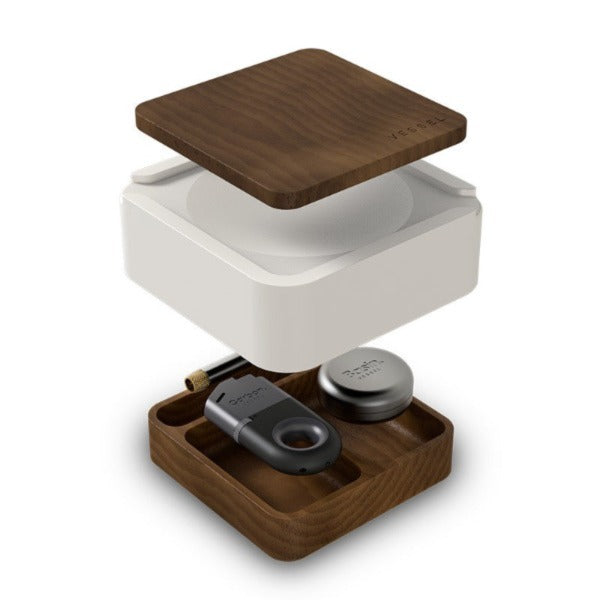Many have become familiar with the cannabinoid CBD and the potential health benefits, but CBD cannabinoids are just one piece of a much larger cannabis puzzle. In fact, there areover 100 different cannabinoids isolated from cannabis that exhibit varied effects. Synthetic cannabinoids can also be produced artificially and encompass a variety of distinct chemical classes.
All of these cannabinoids, their presence, and how they’re highlighted by different strains can potentially impact / enhance the mind and body in unique ways. For example, THC is a cannabinoid, but its effects are far different from its CBD counterpart; THC is theprimary psychoactive compound found in cannabis, while CBD is non-psychoactive. Much of a cannabinoids effect also depends on what cannabinoid receptors they interact with and how —CB1 receptors found primarily in the brain orCB2 receptors predominantly found in the immune system.
However, to learn more about these less discussed cannabinoids and their prospective benefits, taking a step back is in order. Let’s break down the basics of cannabinoids and what makes them so impactful on different cannabis experiences.
What are cannabinoids?
The cannabis plant synthesizes several cannabinoid acids, not just the most popular CBD and THC.These cannabinoid acids must be“activated” or decarboxylated, most often by some level of heat, to produce the most desirable compounds. While that’s usually CBD and THC, many more cannabinoid acids can be produced — just see the chart below.
These acids are unlike THC in that they don’t promote intoxicating-like effects. Although, they can have antibiotic or insecticidal properties, probably initially produced by the cannabis plant, to defend itself from predators and disease. With that being said, different cannabinoids are also believed to impact THC, and the “high” consumers feel. For example, CBD doesn’t get users high but has the potential to influence how THCinteracts with the CB1 receptors in one'sendocannabinoid system and, therefore, a cannabis product's ultimate effect.
Cannabinoids are similar to terpenes in this regard, being guided by anentourage effect of sorts. Some cannabis producers have even startedselective breeding practices to create cannabinoids with more specification, often to attempt to enhance the health benefits of marijuana. Cannabis strains can be made with more CBD for medicinal use or higher THC content for recreational use, all by altering their cannabinoid profiles.
Those are just the mostpopular cannabinoids, though, below are some that create different effects and potential benefits.
Major cannabinoids found in marijuana
|
Cannabinoid |
Name |
Potential Benefits |
|
CBD |
Cannabidiol |
|
|
CBDA |
Cannabidiolic acid |
|
|
CBN |
Cannabinol |
|
|
CBG |
Cannabigerol |
|
|
CBC |
Cannabichromene |
|
|
CBL |
Cannabicyclol |
|
|
CBV |
Cannabivarin |
|
|
THCV |
Tetrahydrocannabivarin |
|
|
CBDV |
Cannabidivarin |
|
|
CBCV |
Cannabichromevarin |
|
|
CBGV |
Cannabigerovarin |
|
|
CBGM |
Cannabigerol monomethyl ether |
|
|
CBE |
Cannabielsoin |
|
|
CBT |
Cannabicitran |
|
CBD - Cannabidiol
CBD’s list of potential health benefits continues to grow lengthy as more research is compiled. Often used to balance the other popular cannabinoid THC, CBD is popularly used to attempt to treat issues likeanxiety,pain / inflammation and more.
CBDA - Cannabidiolic acid
Uniquely, CBDA doesn’t bond directly to the CB1 or CB2 receptors. The cannabinoid actually interacts with the endocannabinoid system and inhibits thecyclooxygenase-2 enzyme. For this reason, CBDA is often associated with the attempted treatment of inflammation and pain following infections.
CBN - Cannabinol
CBN is beginning to gain popularity in the cannabis community, known as the cannabinoid created when THC ages. A few potential benefits of the cannabinoid include that people believe it to be anappetite stimulator,anti-inflammatory andneuroprotectant.
CBG - Cannabigerol
Initial CBG study results are promising, promoting future research with the cannabinoid alone or CBG in combination with others and therapies for the treatment of multiple illnesses. CBG has been found to act on very specific physiological systems and problems, likeeye structures, for example.
CBC - Cannabichromene
CBC has been shown toblock pain and inflammation that is often associated with collagen-induced osteoarthritis and acts very differently from other anti-inflammatory drugs. The cannabinoid CBC is also thought to be a powerfulinhibitor of acne, suppressing excessive lipid production in the sebaceous glands.
CBL - Cannabicyclol
CBL may potentially have medicinal or therapeutic properties, primarily serving as anentourage effect producing cannabinoid / enhancing other cannabinoids. The cannabinoid may also be able toinhibit production of prostaglandins according to some.
CBV - Cannabidivarin
CBV, the second most abundant of the cannabinoidsin cannabis sativa, could potentially assist in the treatment of both psychiatric and mood disorders, as some believe.. Studies have also shown CBV could possibly reducevomiting and nausea.
THCV - Tetrahydrocannabivarin
THCV sets itself apart from other cannabinoids as some believe it can promote thegrowth of new bone and act as anappetite suppressant, much unlike THC. Although THCV is similar to THC in molecular structure and psychoactive properties, it actually provides a range of very different effects.
CBDV - Cannabidivarin
In some studies, CBDV has demonstratedanti-epileptic and anti-convulsive action and is thought to be able to serve as a seriousanti-nausea agent. Like some other cannabinoids, CBDV is also believed to restore / enhance muscle function.
CBCV - Cannabichromevarin
Although little is known about the niche cannabinoid, CBCV is believed to be an effectiveantidepressant. And, if CBCV — when further studied — turns out to have similar benefits to CBC, it could also help users without making them feel intoxicated or impaired in any way, similar to CBD.
CBGV - Cannabigerovarin
CBGV serves as the perfect sidekick for CBD metabolism, as it’s thought to makeCBD more potent in its effects. The cannabinoid is also believed to help soothe a myriad of skin issues andinflammatory skin diseases.
CBGM - Cannabigerol monomethyl ether
Some studies show that the cannabinoid CBGM may actuallymimic the effects of CBG, but lack many of its more undesirable side effects. Like many other cannabinoids like it, CBGM may also aid in the treatment of many conditions likenausea, pain / body aches, and arthritis.
CBE - Cannabielsoin
CBE is known to be a non-psychoactive metabolite of CBD and holds with it the implications it may play an active and vital role in the effects of other cannabinoids present. For example, a study has shown CBE has the potential capacity to be paired with cannabinoids like THC (or an offshoot of such) to possiblytreat cancers.
CBT - Cannabicitran
CBT is a rare offshoot from the THC branch of cannabis. Used in combination with other cannabinoids, CBTcan potentially lessen THC’s different kinds of psychoactive effects. A study has also shown the cannabinoid presentsa possible treatment for glaucoma and conditions alike.
To sum it up:
Ultimately, there exist a plethora of cannabinoids that warrant more research and displaya promising range of potential applications. While THC and CBD cannabinoids are the most popular on the market right now, that could quickly change as more research and information becomes available about others. It may serve cannabis consumers well to pay closer attention to their favorite strains' cannabinoid profile— it may even put them ahead of the next cannabinoid trend.








Leave a comment (all fields required)